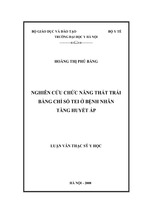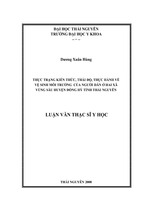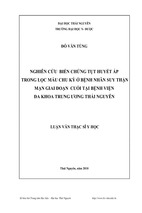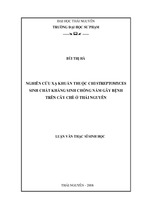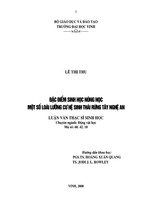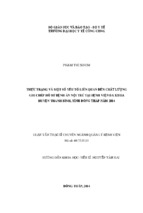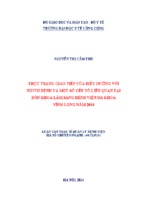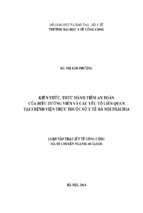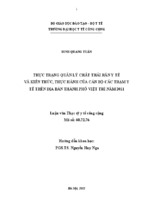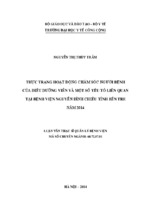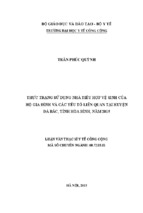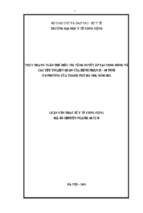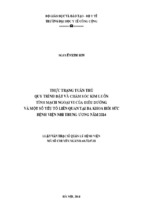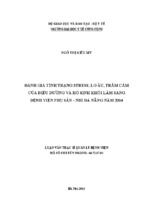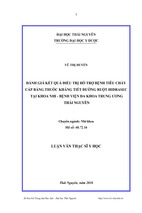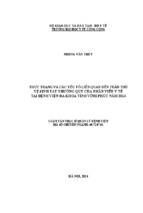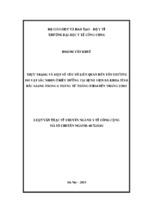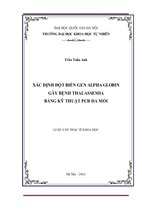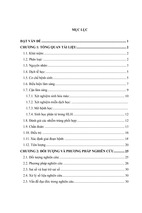Mô tả:
Accountants’ acceptance of a cashless monetary system using an implantable chip
Antony Michael Young
Bachelor of Business (Accounting), Swinburne Institute of Technology
Post Graduate Diploma of Education, Latrobe University
Master of Accounting, University of New England
A thesis submitted to RMIT University for the fulfilment
of the degree of Doctor of Philosophy (PhD.)
July 2007
Acknowledgements
Firstly I want to give a special thanks to my loving wife Ann for her sacrifices during the
duration of my PhD and her support, especially her interest in the issues of the thesis. I also
want to thank my children, Jacinta, Kurtis and Chontelle who never complained when I
worked on the thesis rather than played with them. I want to acknowledge my appreciation to
my Father and Mother for the loving way they supported my intellectual inquiry as I grew.
Academically I want to thank Professor Robert Clift for the support he showed me in the
development of this thesis. His direction and support was fundamental in its development. I
also want to thank my second supervisor Doctor David Gowland for his valuable
contributions, support and patience. A special note of thanks to Professor Clive Morley who
generously devoted time and effort to provide guidance on the statistical interpretations
contained within this PhD.
i
Abstract
A logical control extension surrounding cashless means of exchange is a permanent personal
verification mark. An implanted micro chip such as ones that have been successfully
implanted into humans could identify and store information. Connected with global
positioning satellites and a computer system, a cashless monetary system could be formed in
the future. The system would provide complete and continual real time records for
individuals, businesses and regulators. It would be possible for all trading to occur in this way
in the future. A modified Technology Acceptance Model was developed based on Davis’
(1989) model and Fishbein and Ajzen’s (1975) theory to test the acceptance level of the new
monetary system by professional accountants in Australia. The model includes perceived ease
of use, perceived usefulness, perceived risk, and a subjective norm component. 523
accountants were surveyed in December 2003 with a response rate of 27%. 13% either
strongly agreed or agreed that they would accept the implantable chip. The analysis showed
that Perception of Risk, Subjective Norm and Perception of Usefulness were all significant in
explaining the dependent variable at the 95% confidence level for all responses. The
Perception of Ease of Use was not proved to be significant. In consideration of response bias,
it was found that with respect to the perception of usefulness at the 0.01 level, two elements
were not significant, those being “not having cards” and “having medical information”. The
difference here was not seen as fundamental for the credibility of the research given the main
theme of the research is a monetary system based on the “mark” rather than the convenience
factors of the two elements where there were differences. The perceived risk variable was not
significant for early responders. The responses were also used to analyse the Technology
Acceptance Model developed by Davis (1989). The model had a significance of 0.327
ii
compared to 0.000 giving validation to the contributions of the modified Technology
Acceptance Model. Davis’ (1989) model found Perception of Ease of Use was significant at
the 95% confidence level and Perception of Usefulness was not proven to be significant. In
further analyzing the developed model, each of the elements in the model used as independent
variables were separately regressed against contributions established in open questions
relating to them. Subjective norm had a regression R-squared of 0.403 and of the thirty-four
explanatory variables the only significant contribution, at the 95% confidence level was
“clients”. Significant at the 10% level, were religion, public figures and friends. The
professional bodies variable was not significant in determining the subjective norm. Perceived
Ease of Use and the nine explanatory variables had an R-squared of 0.143. There were only
two significant contributions for ease of use, at the 95% confidence level being “privacy” and
“technology”. Perceived Usefulness and the eleven explanatory variables had an R-squared of
0.205. There were only two significant contributions for usefulness, at the 95% confidence
level being “privacy” and “easy”. Perceived Risk and the eleven explanatory variables had an
R-squared of 0.054 and no significant contributions.
iii
Declaration
Except where reference is made in the text, this thesis contains no material published
elsewhere or extracted in whole or in part from this thesis presented by me for another degree
or diploma.
No other person’s work has been used without acknowledgment in the main text of this thesis.
This thesis has not been submitted for the award of any degree or diploma in any other tertiary
institution.
Antony Young
iv
TABLE OF CONTENT
ACKNOWLEDGEMENTS......................................................................................................I
ABSTRACT ............................................................................................................................. II
DECLARATION....................................................................................................................IV
CHAPTER ONE: INTRODUCTION .................................................................................... 1
1.1 INTRODUCTION .................................................................................................................. 1
1.1.2 Cashless monetary systems explained......................................................................... 2
1.1.3 Factors driving a cashless monetary system............................................................... 3
1.1.3.1 Perceived need to reduce fraud......................................................................... 3
1.1.3.2 Current availability of technology .................................................................... 7
1.1.3.3 Summary ............................................................................................................. 9
1.2 MOTIVATION FOR THE STUDY.......................................................................................... 10
1.3 THE DEVELOPMENT OF CASHLESS MEDIUMS OF EXCHANGE .......................................... 13
1.3.1 Defining money.......................................................................................................... 13
1.3.2 Electronic banking .................................................................................................... 15
1.3.3 Legal aspects of money.............................................................................................. 17
1.3.4 Smart cards ................................................................................................................ 17
1.3.5 Electronic cash .......................................................................................................... 19
1.3.6 Summary .................................................................................................................... 21
1.4 PROBLEMS OF CASHLESS MEDIUMS OF EXCHANGE ......................................................... 22
1.5 VERIFICATION MARK ....................................................................................................... 24
1.6 BENEFITS OF A VERIFICATION MARK .............................................................................. 27
1.7 HAZARDS OF A VERIFICATION MARK............................................................................... 28
1.8 THEORY INTRODUCTION .................................................................................................. 29
1.9 RESEARCH QUESTION....................................................................................................... 32
1.10 METHOD OF THESIS ....................................................................................................... 32
1.11 STRUCTURE OF THESIS .................................................................................................. 33
CHAPTER TWO: LITERATURE REVIEW OF MEDIUMS OF EXCHANGE ........... 35
2.1 TRADITIONALIST PERSPECTIVE ....................................................................................... 35
2.2 ACCOUNTING’S ROLE IN SOCIAL DEVELOPMENT ............................................................ 39
2.3 PROLIFERATION OF CASHLESS MEDIUMS OF EXCHANGE ................................................ 43
2.4 ADVANTAGES OF CASHLESS MEDIUMS OF EXCHANGE .................................................... 51
2.5 DISADVANTAGES OF CASHLESS MEDIUMS OF EXCHANGE ............................................... 53
2.5.1 Cashless mediums of exchange’s propensity to magnify an authority’s control.... 54
2.5.2 Privacy issues arising from cashless mediums of exchanges .................................. 57
2.5.2.1 Technical protection of information............................................................... 60
2.5.2.2 Formal protection of information ................................................................... 61
2.5.3 Abuse ......................................................................................................................... 65
2.5.4 Technology issues...................................................................................................... 66
2.6 METHOD OF IDENTIFICATION .......................................................................................... 67
2.6.1 Identification has become a national issue .............................................................. 67
2.6.2 Identification is a global issue................................................................................... 70
2.6.3 Types of identification solutions ............................................................................... 71
v
2.6.4 Numbering ................................................................................................................. 74
2.6.5 Implantable microchips............................................................................................. 76
2.6.6 Radio Frequency Identification ................................................................................ 77
2.7 MICROCHIPS USED AS HUMAN IDENTIFICATION.............................................................. 77
2.7.1 VeriChip ..................................................................................................................... 78
2.7.2 Digital angel............................................................................................................... 79
2.8 HUMAN IMPLANTATION ................................................................................................... 81
2.9 REAL-TIME UP-DATE ........................................................................................................ 83
2.10 BENEFITS OF A VERIFICATION MARK ............................................................................ 84
2.11 PROBLEMS WITH IMPLANTED CHIPS.............................................................................. 87
2.11.1 Propensity to magnify an authority’s control......................................................... 88
2.11.2 Privacy issues ........................................................................................................... 89
2.11.3 Abuse........................................................................................................................ 91
2.11.4 Technology issues .................................................................................................... 92
2.12 PUBLIC POSITION............................................................................................................ 96
CHAPTER THREE: REVIEW OF TECHNOLOGY ACCEPTANCE THEORY......... 97
3.1 INTRODUCTION................................................................................................................. 97
3.2 DIFFUSION THEORY .......................................................................................................... 98
3.2.1 Acceptance theory.................................................................................................... 100
3.2.2 A Mix of Diffusion theory and Acceptance theory................................................. 102
3.3 THEORY OF REASONED ACTION .................................................................................... 105
3.4 THEORY OF PLANNED BEHAVIOUR ............................................................................... 107
3.5 TECHNOLOGY ACCEPTANCE MODEL ............................................................................ 109
3.6 MODIFIED TECHNOLOGY ACCEPTANCE MODEL .......................................................... 112
CHAPTER FOUR: DESCRIPTION OF THE VARIABLES.......................................... 116
4.1 PERCEIVED EASE OF USE ................................................................................................ 116
4.2 PERCEIVED USEFULNESS ................................................................................................ 117
4.3 PERCEIVED RISKS ........................................................................................................... 118
4.3.1 Potential for social control ...................................................................................... 119
4.3.2 Privacy...................................................................................................................... 120
4.3.3 Abuse........................................................................................................................ 122
4.3.4 System corruption .................................................................................................... 123
4.3.5 Other risks................................................................................................................ 123
4.4 NORMATIVE BELIEFS AND MOTIVATION TO COMPLY ................................................... 124
4.5 RESEARCH QUESTIONS ................................................................................................... 125
4.6 HYPOTHESES .................................................................................................................. 126
4.6.1 Statement of introduction ....................................................................................... 126
4.6.2 Hypotheses............................................................................................................... 127
CHAPTER FIVE: METHODOLOGY AND QUESTIONNAIRE DESIGN ................. 128
5.1 SURVEY ........................................................................................................................... 128
5.1.1 Source selection....................................................................................................... 129
5.1.1.1 Selection of database..................................................................................... 130
5.1.2 Survey numbers selected using CPA Australia and ICA demographics............... 133
5.1.3 CPA demographics .................................................................................................. 136
vi
5.1.3.1 CPA Australia member selection................................................................. 137
5.1.3.2 Institute of Chartered Accountant’s selection............................................ 138
5.2 QUESTIONNAIRE DESIGN ................................................................................................ 138
5.2.1 Scale ......................................................................................................................... 139
5.2.2 Questionnaire structure........................................................................................... 141
5.2.2.1 Test of consistency.......................................................................................... 141
5.2.3 Arrangement of questionnaire structure................................................................ 144
5.2.4 Perceived ease of use............................................................................................... 145
5.2.5 Perceived usefulness................................................................................................ 149
5.2.6 Risks ......................................................................................................................... 151
5.2.6.1 Potential for social control............................................................................. 152
5.2.6.2 Privacy............................................................................................................. 154
5.2.6.3 Abuse ............................................................................................................... 155
5.2.6.4 System corruption .......................................................................................... 157
5.2.6.5 Other risks ...................................................................................................... 159
5.2.7 Normative beliefs and motivation to comply.......................................................... 160
5.2.8 Pre-testing................................................................................................................ 162
5.3 ADMINISTRATION OF THE SURVEY ................................................................................ 164
5.3.1 Survey response rate ............................................................................................... 164
CHAPTER SIX: REPORTING AND ANALYSIS OF RESPONSES ............................ 167
6.1 ACCEPTANCE OF THE “MARK” ...................................................................................... 167
6.1.1 Acceptance of the “mark” if it was compulsory ..................................................... 168
6.1.2 Acceptance of the “mark” by groups ...................................................................... 169
6.2 DESCRIPTIVE RESULTS ................................................................................................... 169
6.2.1 Professional membership and gender of respondents ........................................... 169
6.2.2 Age of respondents................................................................................................... 170
6.2.3 Job position of respondents..................................................................................... 171
6.2.4 Salary of respondents .............................................................................................. 172
6.2.5 Field of work of respondents................................................................................... 172
6.2.6 Numbers of years in the profession of the respondents......................................... 173
6.2.7 Descriptive information summary .......................................................................... 173
6.3 EASE OF USE ................................................................................................................... 173
6.3.1 Ease of physical registration of the “mark” .......................................................... 175
6.3.2 Ease of administratively registering the “mark” ................................................... 176
6.3.3 Ease of access to information using the “mark” ................................................... 176
6.3.4 Ease of using the “mark” to buy and sell .............................................................. 177
6.3.5 Ease of using the “mark” for payment over the phone or computer .................... 177
6.3.6 Ease of using the “mark” to create company records ........................................... 178
6.4 USEFULNESS ................................................................................................................... 178
6.4.1 Usefulness of packages using the information created by the “mark”................. 180
6.4.2 Usefulness of taxation information created by the “mark” .................................. 181
6.4.3 Usefulness of not needing cards because of the “mark”....................................... 181
6.4.4 Usefulness of not having to carry medical and other information because of the
“mark” ..................................................................................................................... 182
6.5 RISK OF THE “MARK” .................................................................................................... 182
6.5.1 Risk of social control due to the “mark”................................................................ 184
6.5.2 Risk of government control due to the “mark”...................................................... 184
6.5.3 Risk of bank control due to the “mark” ................................................................. 185
vii
6.5.4
6.5.5
6.5.6
6.5.7
Risk of private organisation control due to the “mark” ........................................ 185
Legislative protection against risks that may occur because of the “mark” ........ 186
Constitutional protection against risks that may occur because of the “mark”... 187
Risk of privacy loss due to companies receiving additional information
because of the “mark” ............................................................................................ 188
6.5.8 Risk of abuse from companies due to the “mark”................................................. 188
6.5.9 Risk of fraud reduced due to having the “mark” .................................................. 189
6.5.10 Risk of theft reduced because of the “mark”........................................................ 190
6.5.11 Risk of the “mark” reduced because of software encryption............................... 190
6.5.12 Risk of temporary corruption because of the “mark”.......................................... 190
6.5.13 Risk of permanent corruption because of the “mark”......................................... 191
6.5.14 Risk of health issues because of the “mark” ........................................................ 191
6.6 SUBJECTIVE NORM ......................................................................................................... 192
6.6.1 Perception regarding the risk of the “mark” offending respondents’ religious
beliefs ....................................................................................................................... 193
6.6.2 Risk of the “mark” offending community groups ................................................. 194
6.6.3 Perception regarding the risk of the “mark” offending respondents family views
……………………………………………………………………………………………195
6.7 AVAILABILITY OF TECHNOLOGY ................................................................................... 196
6.7.1 Availability of the implantable chip (mark) technology ........................................ 196
6.7.2 Availability of technology surrounding the “mark”.............................................. 197
6.7.3 Availability of combined technology ...................................................................... 197
6.8 VALIDITY OF RESEARCH ................................................................................................ 198
6.8.1 Cronbach’s alpha .................................................................................................... 198
6.8.2 Multi-colinearity ...................................................................................................... 199
6.8.3 Factor analysis ........................................................................................................ 200
6.8.4 Scree plot.................................................................................................................. 202
6.9 MULTINOMIAL LOGIT.................................................................................................... 203
6.9.1 Multinominal logits modelling testing for late response bias................................ 203
6.9.2 Early response.......................................................................................................... 204
6.9.3 Late response ........................................................................................................... 206
6.10 HYPOTHESES TESTING ................................................................................................. 207
6.10.1 Response timing consideration ............................................................................. 209
6.10.2 Hypotheses testing ................................................................................................. 210
6.11 CLASSIFICATION .......................................................................................................... 212
6.12 TECHNOLOGY ACCEPTANCE MODEL .......................................................................... 212
6.13 SUBJECTIVE NORM – OPEN QUESTIONS ....................................................................... 214
6.14 PERCEIVED EASE OF USE – OPEN QUESTIONS .............................................................. 216
6.14.1 Technology issues .................................................................................................. 218
6.14.2 Attitudinal rejection issues .................................................................................... 218
6.14.3 Authority issues...................................................................................................... 219
6.14.4 Misuse issues.......................................................................................................... 219
6.14.5 Privacy issues ......................................................................................................... 219
6.14.6 Health issues .......................................................................................................... 220
6.14.7 Human issues......................................................................................................... 220
6.14.8 Security issues........................................................................................................ 220
6.14.9 Cost issues .............................................................................................................. 221
6.15 PERCEIVED USEFULNESS – OPEN QUESTIONS .............................................................. 221
6.15.1 Medical issues ........................................................................................................ 222
viii
6.15.2 Identity issues......................................................................................................... 222
6.15.3 Security issues........................................................................................................ 223
6.15.4 Recording issues .................................................................................................... 223
6.15.5 Access issues .......................................................................................................... 223
6.15.6 Ease issues ............................................................................................................. 224
6.15.7 Problems................................................................................................................. 224
6.15.8 Privacy issues ......................................................................................................... 225
6.15.9 Protest issues.......................................................................................................... 225
6.15.10 Fraud issues......................................................................................................... 225
6.15.11 Taxation issues .................................................................................................... 225
6.16 PERCEIVED RISK (CONTROL) – OPEN QUESTIONS........................................................ 226
6.16.1 Privacy issues ......................................................................................................... 227
6.16.2 Control issues......................................................................................................... 227
6.16.3 Misuse issues.......................................................................................................... 228
6.16.4 Marketing issues .................................................................................................... 228
6.16.5 Rights issues........................................................................................................... 229
6.16.6 Physical safety issues............................................................................................. 229
6.16.7 Management issues................................................................................................ 229
6.17 PERCEIVED RISKS (OTHER) – OPEN QUESTIONS .......................................................... 230
6.17.1 Misuse issues.......................................................................................................... 230
6.17.2 Control issues......................................................................................................... 231
6.17.3 Health issues .......................................................................................................... 231
6.17.4 Technology issues .................................................................................................. 232
6.17.5 Privacy issues ......................................................................................................... 232
6.17.6 Identity issues......................................................................................................... 233
6.18 FACTORS AFFECTING ACCEPTANCE – OPEN QUESTIONS ............................................. 233
6.18.1 Control issues......................................................................................................... 234
6.18.2 Privacy issues ......................................................................................................... 235
6.18.3 Technology issues .................................................................................................. 236
6.18.4 Misuse issues.......................................................................................................... 236
6.18.5 Health issues .......................................................................................................... 237
6.18.6 Belief issues............................................................................................................ 237
6.18.7 Just no .................................................................................................................... 238
6.18.8 Security issues........................................................................................................ 238
6.18.9 Humanity issues..................................................................................................... 238
6.18.10 Logic issues .......................................................................................................... 239
6.18.11 Convenience issues .............................................................................................. 239
6.18.12 Uniqueness issues ................................................................................................ 240
6.18.13 Benefits issues...................................................................................................... 240
6.18.14 Equity issues ........................................................................................................ 240
6.18.15 Spouse issues........................................................................................................ 241
6.18.16 Existence issues ................................................................................................... 241
CHAPTER SEVEN: CONCLUSION................................................................................. 242
7.1 INTRODUCTION............................................................................................................... 242
7.2 ACCEPTANCE LEVEL ...................................................................................................... 243
7.3 FINDINGS ........................................................................................................................ 244
7.4 RESPONSE BIAS ............................................................................................................... 245
7.5 OPEN QUESTIONS............................................................................................................ 246
ix
7.6 RESEARCH CONTRIBUTIONS .......................................................................................... 247
7.7 RECOMMENDATIONS ...................................................................................................... 248
7.8 FURTHER RESEARCH ...................................................................................................... 249
BIBLIOGRAPHY ................................................................................................................ 251
x
APPENDICES
1. Descriptive statistics
1.1
Professional affiliation of respondents
1.2
Gender of respondents
1.3
Age of respondents
1.4
Years in the profession of the respondents
1.5
Salary of the respondents
1.6
Position of the respondents
1.7
Field of work of the respondents
1.8
Perception of the respondents regarding the ease
of the physical registration process
1.9
Perception of the respondents regarding the ease of the
administration of registering of the “mark”
1.10 Perception of the respondents regarding the ease of access
to information using the “mark”
1.11 Perception of the respondents regarding the ease of using
the “mark” to buy and sell
1.12 Perception of the respondents regarding the ease of using the
“mark” for payments over the phone or on the computer
1.13 Perception of the respondents regarding the ease of using the
“mark” to create company records
1.14 Perception of the respondents regarding the usefulness of
packages using the information created by the “mark”
1.15 Perception of the respondents regarding the usefulness of taxation
information created by the “mark”
1.16 Perception of the respondents regarding the usefulness of not needing
cards because of the “mark”
1.17 Perception of the respondents regarding the usefulness of having
medical and other information on the “mark”
1.18 Perception of the respondents regarding the risk of government
social control due to the “mark”
1.19 Perception of the respondents regarding the risk of government
control via affiliations due to the “mark
xi
1.20 Perception of the respondents regarding the risk of bank control
due to the “mark”
1.21 Perception of respondents regarding the risk of private
organisation control due to the “mark”
1.22 Perception of the respondents regarding the risk protection
regarding the “mark” afforded by legislation
1.23 Perception of the respondents regarding the risk
protection provided by constitution regarding the “mark”
1.24 Perception of the respondents regarding the risk of lost privacy
due to companies receiving additional information because
of the “mark”
1.25 Perception of respondents regarding the risk of abuse from
companies due to the “mark”
1.26 Perception of respondents regarding the risk of fraud reduced
1.27 Perception of respondents regarding the risk of theft reduced
1.28 Perception of respondents regarding the risks reduced by
software encryption
1.29 Perception of respondents regarding the risks of temporary
corruption
1.30 Perception of respondents regarding the risks of permanent
corruption
1.31 Perception of respondents regarding the risks of health issues
1.32 Perception of respondents regarding the risks of offending
religious groups
1.33 Perception of respondents regarding the risks of offending
community groups
1.34 Perception of respondents regarding the risks of conflicting with
family views
1.35 Respondents perceptions regarding whether groups find using the
“mark” easy to use
1.36 Respondents perceptions regarding whether groups find the “mark”
useful
1.37 Respondents perceptions regarding whether groups find the “mark”
xii
risky
1.38 Perception of respondents regarding whether the “mark” technology
is available
1.39 Perception of respondents regarding whether the technology
surrounding the “mark” is available
1.40 Perception of respondents regarding whether the combined “mark”
technology is available
1.41 Perception of respondents regarding the acceptance of the “mark”
by groups
1.42 Perception of respondents regarding the acceptance if the “mark”
was a major means of transacting
1.43 Perception of respondents regarding the acceptance of the
“mark” if it was compulsory
2. Influences cited as most important influence
2.1
Most important influence (subjective norm – open question)
2.2
Influences cited as the second most important influence
2.3
Influences cited as the third most important influence
2.4
Influences cited as the fourth most important influence
3. Perceived ease of use (open question)
3.1
Technology issues
3.2
Attitudinal rejection issues
3.3
Authority issues
3.4
Misuse issues
3.5
Privacy issues
3.6
Health issues
3.7
Human issues
3.8
Security issues
3.9
Cost issues
xiii
4. Perceived usefulness (open question)
4.1
Medical issues
4.2
Identity issues
4.3
Security issues
4.4
Recording issues
4.5
Access issues
4.6
Ease issues
4.7
Problems
4.8
Privacy issues
4.9
Protest issues
4.10 Fraud issues
4.11 Taxation issues
5. Perceived risk (control – open question)
5.1
Privacy issues
5.2
Control issues
5.3
Misuse issues
5.4
Marketing issues
5.5
Rights issues
5.6
Physical safety issues
5.7
Management issues
6. “Other” Risks (open question)
7.
6.1
Misuse issues
6.2
Control issues
6.3
Health issues
6.4
Technology issues
6.5
Privacy issues
6.6
Identity issues
Factors affecting acceptance (open – question)
7.1
Control issues
7.2
Privacy issues
7.3
Technology issues
7.4
Misuse issues
7.5
Health issues
xiv
7.6
Belief issues
7.7
Just no
7.8
Security issues
7.9
Humanity issues
7.10 Logic issues
7.11 Convenience issues
7.12 Uniqueness issues
7.13 Benefits issues
7.14 Equity issues
7.15 Spouse issues
7.16 Existence issues
LIST OF CHARTS
Chart 1.1
Modified Technology Acceptance Model
31
Chart 2.1
Non-cash payment per capita (per year) in Australia
45
Chart 2.2
Combined value and volume for products other than cash
47
Chart 3.1
Outlines the Theory of Reasoned Action
105
Chart 3.2
Theory of Planned Behaviour
108
Chart 3.3
Technology Acceptance Model (Davis 1989)
111
Chart 3.4
Modified Technology Acceptance Model
115
Chart 5.1
Modified Technology Acceptance Model
144
xv
LIST OF TABLES
Table 2.1
Credit card usage
48
Table 2.2
Direct debt usage
49
Table 2.3
EFTPOS usage
49
Table 2.4
Electronic credits usage
50
Table 2.5
ATM usage
50
Table 2.6
Cheque usage
51
Table 5.1
Total numbers of members in the Institute
of Chartered Accountants and CPA Australia
Table 5.2
Membership by regions
(From CPA Australia 2000 annual report)
Table 5.3
133
134
Memberships - Australia only
(Constructed from Table 2)
135
Table 5.4
Membership –Australia only
135
Table 5.5
Ratio of women to men in CPA Australia
136
Table 5.6
Questionnaire by style
142
Table 5.7
Responses break down
161
Table 6.1
The percentage of acceptance if it was compulsory
164
Table 6.2
Salary range of the respondents
168
Table 6.3
Field of work of the respondents
168
Table 6.4
Ease questions’ characteristics
170
Table 6.5
Easy administration registration percentage
172
Table 6.6
Usefulness questions’ characteristics
175
Table 6.7
The percentage of useful taxation information
177
Table 6.8
Risk questions’ characteristics
179
Table 6.9
Risk of government control due to the “mark”
181
Table 6.10
Risk of private organisation control due to the “mark”
182
Table 6.11
The percentage of risk of privacy from companies
184
Table 6.12
The percentage of risks for temporary corruption
187
Table 6.13
Subjective norm frequency questions’ characteristics
188
Table 6.14
The percentage for risks of offending community groups
190
Table 6.15
The percent of the other technology is available
193
xvi
Table 6.16
Cronbach’s alpha for respondents’ contribution
195
Table 6.17
Tolerance and VIF
196
Table 6.18
Rotated Component Matrix(a)
197
Table 6.19
Descriptive Statistics (a)
200
Table 6.20
Model Fitting Information
201
Table 6.21
Likelihood Ratio Tests
201
Table 6.22
Model Fitting Information
202
Table 6.23
Likelihood Ratio Tests
202
Table 6.24
Acceptance if it was a major means of transacting
203
Table 6.25
Model Fitting Information
204
Table 6.26
Pseudo R-Square
204
Table 6.27
Likelihood Ratio Tests
205
Table 6.28
Classification
208
Table 6.29
Model Fitting Information
209
Table 6.30
Pseudo R-Square
209
Table 6.31
Likelihood Ratio Tests
210
Table 6.32
All influences cited
211
xvii
LIST OF GRAPHS
Graph 6.1
Acceptances if “mark” was a major means of transacting
164
Graph 6.2
Age of respondents
167
Graph 6.3
The respondent’s contributions of using ease
170
Graph 6.4
Ease of physically registering the “mark
171
Graph 6.5
Ease of using the “mark” for payments
over the phone or computer
174
Graph 6.6
Usefulness of using “mark” – whole
175
Graph 6.7
Usefulness of packages using
the information created by the “mark”
176
Graph 6.8
Risk questions’ characteristics
179
Graph 6.9
Risk of social control due to the “mark”
180
Graph 6.10
Protection afforded
by legislation from affects of the “mark”
183
Graph 6.11
Risk of fraud reduced because of the “mark”
185
Graph 6.12
Subjective Norm Frequency
188
Graph 6.13
Risk that “mark” offends religious beliefs
190
Graph 6.14
Risks of “mark” offending family views
191
Graph 6.15
Availability of “mark
192
Graph 6.16
Scree Plot
199
xviii
Chapter One: Introduction
1.1
Introduction
1.1.1 Research introduced
Professional accountants are trained to deal with change. Their opinions are sought in
new uncertain financial circumstances such as an emerging taxation system. This
research solicits accountants’ views of accepting an emerging cashless monetary system.
The system revolves around microchips implanted into humans accessed by individual
scanners and embracing global positioning satellites supported by computers which
record transactions. A person would present their implanted microchip (referred to as a
verification mark) which would most likely be implanted in their wrist to the scanner
which would scan the microchip in the same way a barcode of a product is scanned at a
supermarket. The scanner would make a transfer of the amount agreed should sufficient
funds or credit allow, otherwise it would be disallowed and an error message would be
displayed on the scanner. Personal monetary exchanges would happen in the same way
using small portable scanners normally part of a mobile phone. The debits or credits in a
person’s bank account would be updated in real time on the central computer via
satellite.
1
- Xem thêm -

